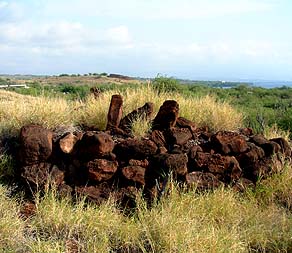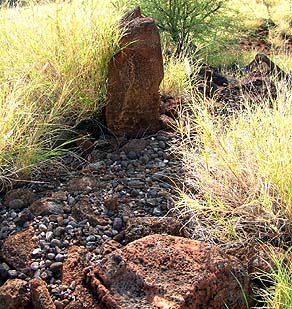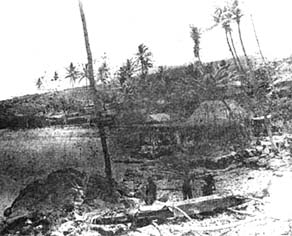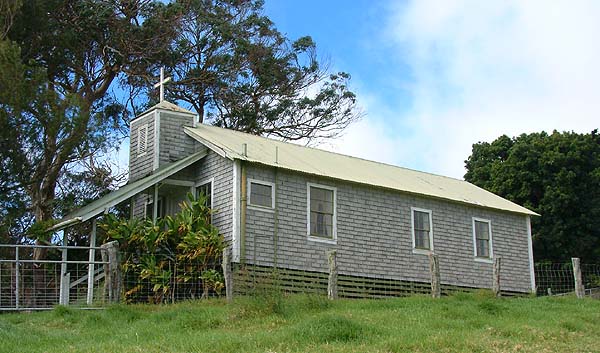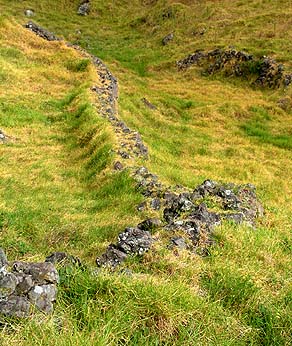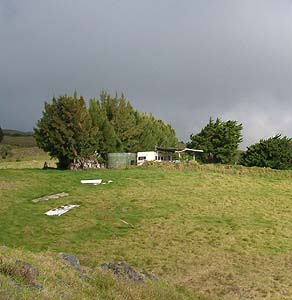 |
 |
 |
|||||
|
|
|||||||
|
|
|||||||
| |
|
|
|
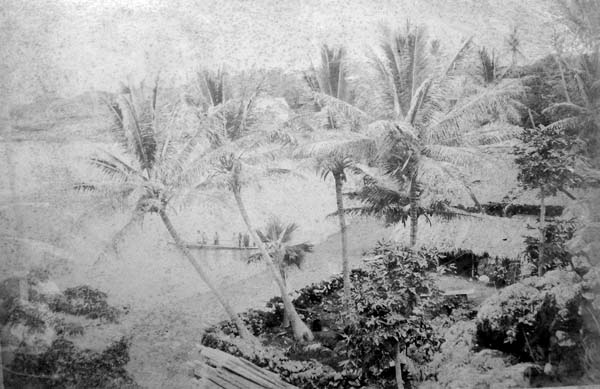
|
Kawaihae is "a village containing one hundred houses" wrote William Ellis, a British Missionary who traveled through the islands in 1824. Ellis and his companions estimated "five persons to each house, which we think is not far from a correct calculation." This would give an estimate of 500 persons living in Kawaihae at that time (Ellis 1969: 121, 399).
|
||
|
|
||
“During the first census of Hawai‘i island in 1832,” Chiogioji & Hammatt write, “a total population of 8,679 was recorded in the Kohala district. Three years later, in the census of 1835, the total Kohala population had dropped to 6,175. In the 1835 census, the Kawaihae ahupua‘a population was indicated: 150 adult males, 178 adult females, and 109 children” (Chiogioji & Hammatt 1997: 16). Reverend Lyons noted that taxes were being levied in proportion to the number of children, and that people were either hiding children or having fewer. “The congregation at Kawaihae varied from 100 to 400 persons,” Marion writes, “and in 1841, the population was reported to have been 726 persons (about 300 less than the previous year). Drought and other changes during those years had forced many people to move away.” “Famine reigns and consequently the people suffer,” Lyons wrote in 1846. “They are mostly dependent on other places for vegetable production. But as there is no certainty of regular supply, the people are often reduced to extremities” (in Kelly 1974: 30).
|
|
|
“During the 1853 smallpox epidemic, the remaining population of Kawaihae was nearly finished off,” Marion states. John Papa ‘I‘i had left O‘ahu where a smallpox-carrying ship had docked and the disease first began to spread. While in Kailua, he reported that “After two or three days there, news came that the smallpox was now raging at Kawaihae. Several persons, including Puamana, were dead; but those who had been vaccinated were saved.” ‘I‘i noted, “It was said that some people from Oahu had caused the spread of the disease” (Ii 1959: 171). “Lyons’ remarks on his congregation at that time reveal his despair," Marion adds. " ….I could not refrain from weeping when I entered there” Lyons described. “It was a sad and desolate scene. In April one hundred communicants were present, many were in the full bloom of life—now there were but twenty four, and not a youth among them…." (Mission Station Report, 1853, from Kelly 1974: 31).
|
|
|
|
“There’s an interesting study of the census of the 19th century," Hannah remarks. "In it, as the numbers of Hawaiians decline, the footnotes are peppered with proclamations by the missionaries that this decline in population is because of the unrighteous living of the people. The missionaries were using that population decline as sort of a lever to advance their vision of God. "I think that Lorenzo Lyons stands out in his heart for Hawai‘i and its people. Some of the other missionaries seemed to be implementing and embodying the wrath of the Old Testament God. God should show a different face under Christianity. And I think that Lorenzo Lyons embodies that loving face of Christianity, as juxtaposed with some others who just seemed very vengeful and wrathful to the people."
|
||
|
|
||
A nine-month drought affected Waimea and South Kohala in 1856. "By the end of the 1850s, the area had apparently recovered," Chiogioji & Hammatt write. In January 1859, the new church was dedicated at Kawaihae Village. Lyons wrote, "A great day. Procession of three hundred with flutes and flags. Formed a circle for speeches, prayer, an original ode. Contributions enough to pay off the debt. Procession formed again. Marched up to Puukohola, the old heiau. Prayer there and singing. Then marched to the old church to say farewell. At last marched to the new church and dedicated it. A day long to be remembered" (Doyle 194, quoted in Chiogioji & Hammatt 1997: 27).
|
|
|
"The village consists chiefly of a single large wooden structure which serves as a country store and warehouse for the products of the district," wrote Charles de Varigny, secretary of the French Consulate in Honolulu, in 1861. "Around the shop are clustered several makeshift buildings providing annexes for further storage. Scattered along the seashore are a few kanaka grass houses, about twenty. "The setting is desolate: not a blade of grass, not a tree, except for the infrequent coconut palms, nor a stream. Enormous volcanic rocks, jagged and cinder-black, lie strewn across the ground, and a fine, dustry sand covers the beach. A small wharf serves for the departure and landing of travelers. At a short distance from shore floats an old stripped-down vessel, its melancholy hull balancing at anchor and providing storage for producings arriving from Honolulu. It was difficult for me to imagine a more arid and barren setting" (quoted in Chiogioji & Hammatt 1997: 28).
|
|
|
|
|
“In the mid nineteenth century,” Langlas writes, “there was also a substantial population of Hawaiians at Kawaihae Uka in the uplands of the two Kawaihae, probably larger than the population at Kawaihae Bay.” “Congregational church records kept by Lorenzo Lyons indicate that the upland population fell into two groups, each of which built a church in 1861. An upland community called by Lyons Kaalaia (North Kawaihae Uka) built the church named "Mount Horeb [Mauna Horepa in Hawaiian, which became 'Hoepa']. The community called by Lyons Makela (Kawaihae Uka proper) built the church named Sinai, probably near Pu‘u Makela. “According to church membership lists, the two settlements together had an adult population of 360 in 1857 (217 at Kaalaia and 144 at Makela). Four years later in 1861, the adult population had fallen to 325 (176 at Kaalaia and 149 at Makela)."
|
||
|
|
||
"This loss of population must represent a continuing downward trend, due to disease and out-migration. The historically known epidemics of 1848 (measles, whooping cough) and 1853 (smallpox) killed many Hawaiians in the Waimea/Kawaihae area, according to Lyons. Smallpox and other diseases as well must have continued to reduce the population after that. Lyons was still vaccinating for smallpox in 1869” (Langlas, 1994: 16). This population “apparently derived from an even larger population living there earlier and subsisting on upland agriculture. This substantial population at Kawaihae Uka may date from the late precontact period, or it may have developed in the early nineteenth century as Hawaiians moved upland to grow sweet potatoes and feed pigs for the provisioning trade which developed at Kawaihae port” (Langlas 1994: 15-6).
|
|
|
"The population of Kawaihae Uka dwindled after the 1860's, but there were still two small Hawaiian communities there in the 1920s," Langlas learned from his informant, Helen Aveiro Awaa,"one at Horepa and one at Keawewai/Makela. "By the 1930's the Awaa and Iokepa families were the last ones left at Horepa....By the early 190s, the community was gone....About 1952, the Mauna Horepa church was moved to Kahua Ranch, since there were no families left at Horepa. It was joined together with another old Kohala church to make a larger structure. After 1950, the Awaa house was occupied periodically by members of the Hui family who inherited the property."
|
|
|
|
| "Kawaihae is a water-challenged area," Hannah emphasizes. "But, even up into Sam Parker’s times there were initiatives and schemes and desires to cause it to be more of a hub than it ever became. I think there was experimentation with sugar up in Kohala and then the gardening and cattle works that were being done up what is now the Kawaihae road corridor. There certainly were reasons to further urbanize Kawaihae. But I think it just fell short for a number of factors, like lack of water, and other locations being better suited to it."
|
||
|
|
||
These shifts and changes in the population were linked to broader structural changes in the economy of the area and of the islands as a whole. These changes are part of the aftermath of the Mahele.
|
||
|
|
||
|
|
|
|
|
|

|
| Kawaihae Home | Map Library | Site Map | Hawaiian Islands Home | Pacific Worlds Home |
|
|
|
|
|
|
|||
| Copyright 2006 Pacific Worlds & Associates • Usage Policy • Webmaster |
|||
